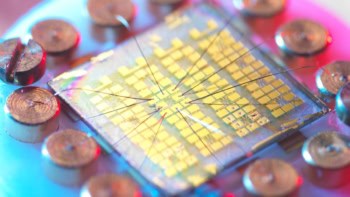
Since its inception, quantum theory has presented us with many strange and seemingly paradoxical phenomena. One of the oddest examples is the quantum Cheshire cat effect, in which properties of quantum objects become disembodied from the objects themselves. Now, two of the researchers who predicted the effect have shown that it is even weirder than they first thought: not only can quantum properties become detached from their parent objects, these properties can also move of their own accord and interact with distant regions even if the object itself never travels there.
The concept of a quantum Cheshire cat was introduced in 2013 by a team of researchers from Israeli and UK universities who took their inspiration from the eponymous disappearing cat in Lewis Carroll’s novel Alice’s Adventures in Wonderland. Just as Carroll’s Cheshire cat can vanish at will, leaving nothing but a grin behind, a quantum particle may become completely separated from its own properties. While the idea may seem outlandish at first, the effect has since been demonstrated experimentally by separating a beam of neutrons from their magnetic moments.
A new spin on the quantum Cheshire cat
In the latest development, two authors of the original paper, Yakir Aharonov of Tel Aviv University and Sandu Popescu from the University of Bristol, teamed up with Eliahu Cohen of Bar Ilan University to imagine a box with a spin-½ particle in it. If they measure the spin of such a particle along any of three axes in space, they will find it to be pointing in one of two directions: up or down, left or right, forward or back. The box has a partition in the middle (indicated by the yellow line in the figure below), and this partition has an infinitesimal probability of allowing the particle (represented by the red crest) to pass through. The box’s right wall, meanwhile, is transparent if the particle’s spin points up; otherwise, the particle will bounce back. The right wall is also the only place that can affect the particle’s spin; in physical terms, it could be realized with a magnetic field oriented along the up-down (z) axis.

At the beginning of this thought experiment, the particle is on the left-hand side of the box with its spin pointing up (+z). It then moves to the right, mostly bounces off the partition and leaks an infinitesimally tiny bit through. This tiny bit should still have its spin pointing up, so it passes through the right-hand side of the box and out into the environment. Over a very long period, the particle should leak out of the box completely.
A box paradox
Surprisingly, the team found that even while the particle is still firmly measured to be on the left-hand side of the box, the direction of its spin along the x-axis (right or left) appears to flip during the experiment. The source of this spin flip is the small amount of the particle’s z-axis spin that leaks through the partition and interacts with the magnetic field barrier at the right wall; the researchers showed mathematically that this interaction flips the particle’s x-axis spin even though the particle mostly remains on the left-hand side. This apparent flip could also be shown experimentally by so-called weak measurements, which do not disturb the particle’s wavefunction enough to collapse it. Such measurements therefore allow researchers to compare the spin’s direction at the beginning of the experiment with its direction after the particle has bounced back and forth several times.
The reason this flip seems strange is that apart from the right wall, no part of the box influences the spin’s direction. However, if at the end of the experiment the particle is measured to be on the left side of the box, and whatever small amount of it that tunnelled through to the right side has leaked out, then intuitively the particle’s spin should not have changed. The fact that it does indeed change shows that the particle’s spin has travelled to the right side of the box without the particle ever leaving the left. This is the quantum Cheshire cat effect, where the “grin” bounces around the box even as the cat itself remains on one side.
Counterfactual communication
One consequence of this novel phenomenon is counterfactual communication – that is, a way of sending information without sending a physical particle. For example, two people could send information from the right side of the box to the left without the particle ever leaving the left side, simply by having the person on the right turn the spin-dependent barrier on or off. The person on the left would then receive information by measuring whether the direction of the x-axis spin has flipped or not.

Quantum Cheshire cat spotted in Grenoble
Although such a protocol would require many measurements to be accurate, the researchers argue that the dynamic quantum Cheshire cat effect could, in principle, be incorporated into existing, more efficient counterfactual communication protocols in the future. This is not, however, their primary concern in the paper, which is published in Nature Communications. “What is the most important for us is not a potential application – though that is definitely something to look for – but what it teaches us about nature,” Popescu tells Physics World. “Quantum mechanics is very strange, and almost a hundred years after its discovery it continues to puzzle us. We believe that unveiling even more puzzling phenomena and looking deeper into them is the way to finally understand it.”



